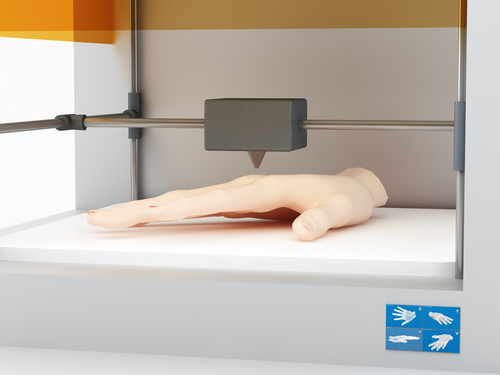Researchers from Pohang University of Science and Technology in South Korea have developed a new 3D printing method that reduces both the time and cost required to biofabricate (or bioprint) human skin, a process which has previously required multiple steps to complete.
The new 3D cell printing strategy, reported in the journal Biofabrication, enables scientists engineer human skin using only a single step, which reduces fabrication costs by a factor of 50 and the amount of material required by a factor of 10.

The new skin model developed by the team features a supportive 3D construct, enabling the maturation of the skin model (Credit: Shutterstock user: belekekin)
Bioprinting refers to the layer-by-layer deposition of cells to produce artificial tissues that mimic natural tissues in both form and function. The technique can be used in regenerative medicine, the act of replacing damaged and failing human organs with artificially printed copies
According to lead author Professor Dong-Woo Cho of the university’s department of mechanical engineering: ‘Although several approaches have been explored for developing biomimetic human skin models, the present skin models, which are still based on multistep production methods using polydimethylsiloxane (PDMS) chips and commercial cell culture inserts, could be limited in making a versatile design that facilitates the development of various functional human skin models. In this regard, 3D cell-printing technique could establish a new era for advanced skin models.’
The researchers’ strategy features a hybrid 3D cell-printing system, which allows both extrusion and inkjet modules to be used on the printer at the same time. By using the printer’s extrusion-dispensing module, the scientists were able to engineer a collagen-based material with a polycaprolactone (PCL) membrane.
‘PCL is a biodegradable polyester that prevents collagen’s contraction during tissue maturation,’ commented Cho. ‘Meanwhile, we used the inkjet-based dispensing module to uniformly distribute keratinocytes – the predominant cell type in the outermost layer of the skin – onto the engineered skin.’
The new skin model developed by the team features a supportive 3D construct, enabling the maturation of the skin model without the use of commercial cell culture inserts. The skin model also displays good biological characteristics, including a stabilised/fibroblast-stretched dermis, and stratified epidermis layers after 14 days.
‘Significantly, our new method is around 50 times cheaper than alternative methods, and requires 10 times less base material,’ Cho remarked. ‘We hope that this new single-step process could provide an attractive and useful platform for engineering fully functional human skin models.’
The global 3D bioprinting market is set to reach $1.8 billion by the year 2027, according to research carried out by IDTechEx. According to the report, this is because several major applications of 3D bioprinting - such as regenerative medicine or the production of cell-based biosensors - are ready to be realised after more 15 years of research and development.

